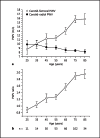Arterial Stiffness Gradient
- PMID: 27195235
- PMCID: PMC4865077
- DOI: 10.1159/000438852
Arterial Stiffness Gradient
Abstract
Background: Aortic stiffness is a strong predictor of cardiovascular mortality in various clinical conditions. The aim of this review is to focus on the arterial stiffness gradient, to discuss the integrated role of medium-sized muscular conduit arteries in the regulation of pulsatile pressure and organ perfusion and to provide a rationale for integrating their mechanical properties into risk prediction.
Summary: The physiological arterial stiffness gradient results from a higher degree of vascular stiffness as the distance from the heart increases, creating multiple reflective sites and attenuating the pulsatile nature of the forward pressure wave along the arterial tree down to the microcirculation. The stiffness gradient hypothesis simultaneously explains its physiological beneficial effects from both cardiac and peripheral microcirculatory points of view. The loss or reversal of stiffness gradient leads to the transmission of a highly pulsatile pressure wave into the microcirculation. This suggests that a higher degree of stiffness of medium-sized conduit arteries may play a role in protecting the microcirculation from a highly pulsatile forward pressure wave. Using the ratio of carotid-femoral pulse wave velocity (PWV) to carotid-radial PWV, referred to as PWV ratio, a recent study in a dialysis cohort has shown that the PWV ratio is a better predictor of mortality than the classical carotid-femoral PWV.
Key messages: Theoretically, the use of the PWV ratio seems more logical for risk determination than aortic stiffness as it provides a better estimation of the loss of stiffness gradient, which is the unifying hypothesis that explains the impact of aortic stiffness both on the myocardium and on peripheral organs.
Keywords: Aortic stiffness; Arterial stiffness gradient; End-organ damage; Medium-sized muscular artery; Mortality.
Figures


References
-
- Ben-Shlomo Y, Spears M, Boustred C, May M, Anderson SG, Benjamin EJ, Boutouyrie P, Cameron J, Chen C H, Cruickshank JK, Hwang SJ, Lakatta EG, Laurent S, Maldonado J, Mitchell GF, Najjar SS, Newman AB, Ohishi M, Pannier B, Pereira T, Vasan RS, Shokawa T, Sutton-Tyrell K, Verbeke F, Wang KL, Webb DJ, Willum Hansen T, Zoungas S, McEniery CM, Cockcroft JR, Wilkinson IB. Aortic pulse wave velocity improves cardiovascular event prediction: an individual participant meta-analysis of prospective observational data from 17,635 subjects. J Am Coll Cardiol. 2014;63:636–646. - PMC - PubMed
-
- Laurent S, Boutouyrie P, Asmar R, Gautier I, Laloux B, Guize L, Ducimetiere P, Benetos A. Aortic stiffness is an independent predictor of all-cause and cardiovascular mortality in hypertensive patients. Hypertension. 2001;37:1236–1241. - PubMed
-
- Blacher J, Guerin AP, Pannier B, Marchais SJ, Safar ME, London GM. Impact of aortic stiffness on survival in end-stage renal disease. Circulation. 1999;99:2434–2439. - PubMed
-
- Cruickshank K, Riste L, Anderson SG, Wright JS, Dunn G, Gosling RG. Aortic pulse-wave velocity and its relationship to mortality in diabetes and glucose intolerance: an integrated index of vascular function? Circulation. 2002;106:2085–2090. - PubMed
-
- Pannier B, Guerin AP, Marchais SJ, Safar ME, London GM. Stiffness of capacitive and conduit arteries: prognostic significance for end-stage renal disease patients. Hypertension. 2005;45:592–596. - PubMed
Publication types
LinkOut - more resources
Full Text Sources
Other Literature Sources
Medical

